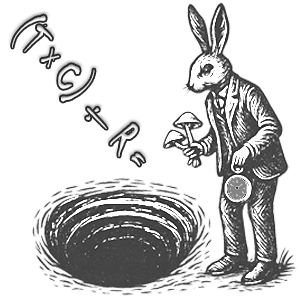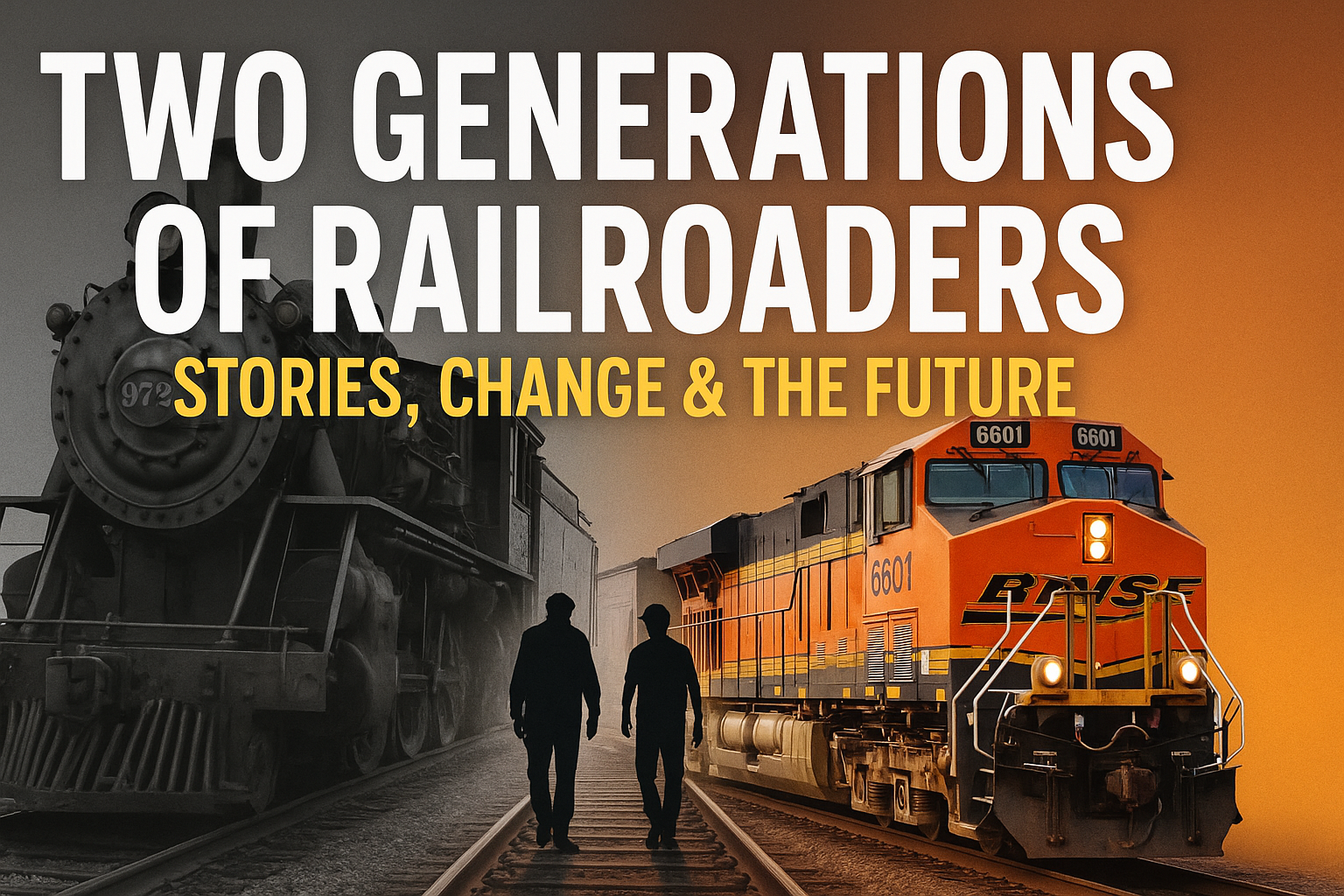A deep dive into the evolution of American railroads through the eyes of a father-son duo with a combined 57 years of experience on the rails.
The Generational Divide: From Three Days to Six Months
The conversation between Doug Sado, who started his railroad career in 1968, and his son Spenser, who began in 2014, immediately reveals the dramatic changes in how railroad workers are trained. Doug received just three days of on-the-job training before being sent to work—a stark contrast to Spenser’s six-month comprehensive training program.
This shift reflects broader changes in industrial safety culture, liability concerns, and the increasing complexity of modern railroad operations. What once relied heavily on experienced workers passing down knowledge informally has evolved into structured, regulated training programs that prepare workers for highly technical and safety-critical roles.
The Technology Revolution on the Rails
Communication: From Hand Signals to Digital Networks
One of the most striking changes discussed is the evolution of communication systems. Doug’s early career required mastery of an extensive vocabulary of hand signals—everything from numbers and letters to complex operational commands. When radios were finally introduced, they came as heavy, phone-sized boxes worn around the neck.
Spenser’s generation operates in a world of digital communication, yet hand signals remain relevant. Interestingly, many newer workers are uncomfortable with hand signals, preferring radio communication despite its potential for creating compliance issues. This represents a fascinating tension between old-school reliability and modern convenience.
From Cabooses to FREDs
The elimination of cabooses represents more than just technological advancement—it symbolizes the railroad industry’s ongoing battle between safety, efficiency, and cost reduction. Originally, trains ran with 40-50 cars, allowing visual communication between the head and rear. As trains grew to 200+ cars, the traditional caboose became impractical, replaced by FRED (Flashing Rear End Device) technology that allows remote brake control from the locomotive.
This change eliminated jobs while theoretically maintaining safety, but it also removed the human element that could spot problems, make real-time decisions, and provide situational awareness that technology might miss.
Remote Control Operations and Automation
Doug’s transition to Remote Control Operator (RCO) near retirement represents an intermediate step toward full automation. These systems allow trains to be operated via handheld remote controls, primarily in rail yards and industrial settings.
Today’s trains incorporate even more advanced automation:
- Trip Optimizer: Essentially autopilot for trains, managing speed, fuel consumption, and adherence to schedules
- Positive Train Control (PTC): Safety systems that can automatically stop trains to prevent collisions or derailments
The Human Cost of Industrial Progress
Safety: A Double-Edged Story
The safety improvements in railroading are undeniable. Spenser mentions union statistics showing a dramatic reduction in reportable injuries—from approximately 16,000 in 1992 to just 13 in 2025 (though these numbers would need verification). Doug personally knew five or six workers who died on the job during his career.
However, increased safety comes with decreased efficiency. Doug notes that switching operations that once moved quickly now take much longer due to safety protocols. This raises complex questions about the acceptable trade-offs between worker safety, operational efficiency, and economic viability.
The Changing Culture of Work
Doug’s stories reveal a dramatically different workplace culture. His anecdotes about drinking on the job—including maintaining a daily supply of “100-proof bourbon and a case of beer” at one yard—seem almost unimaginable in today’s regulatory environment. Even supervisors participated in this culture, reflecting different attitudes toward workplace behavior and personal responsibility.
This cultural shift mirrors broader changes in American industrial work, where strict policies, drug testing, and liability concerns have largely eliminated the informal, looser workplace relationships of previous generations.
Economic Pressures and Job Elimination
The Disappearing Workforce
The conversation reveals the ongoing elimination of railroad jobs. Brakemen, once essential crew members, have been almost entirely eliminated in the Northwest. The traditional three-person crew (engineer, conductor, brakeman) has been reduced to two, and further automation threatens even these remaining positions.
Spenser predicts conductors will likely be eliminated within 5-10 years, with engineers potentially lasting longer in a role similar to airline pilots—present for safety and emergency situations but not actively operating the equipment most of the time.
The Economics of Automation
The railroad industry’s push toward automation is driven by the same economic pressures affecting many industries: labor costs, consistency, and liability reduction. However, railroads face unique challenges that make full automation complex:
- Infrastructure complexity: Unlike highways, rail networks involve switches, signals, and right-of-way issues
- Environmental variables: Weather, track conditions, and obstacles require real-time decision-making
- Security concerns: The rise in train robberies (described as being at historic highs) suggests the need for human oversight
- Emergency response: Situations like Spenser’s encounter with a child on the tracks demonstrate the value of human judgment and quick response
Modern Challenges: Security and Crime
The Return of Train Robbery
Contrary to popular belief, train robbery is experiencing a resurgence, though with modern methods. Instead of horseback bandits, today’s train robbers use vehicles and target long trains parked in sidings. The length of modern trains (often 200+ cars) makes it difficult for crews to monitor the entire consist, creating opportunities for theft.
The railroad industry transports everything from consumer goods to military equipment and radioactive materials. Spenser describes hauling tanks to military bases and cars marked with nuclear symbols, highlighting the security implications of railroad operations.
Gender and Diversity in Railroading
The statistics on women in railroading tell a story of slow progress. While overall railroad employment includes about 24% women, only 1.4% of train and engine workers are women. This reflects the industry’s traditionally male-dominated culture and the physical demands of railroad work, though these barriers are gradually changing.
Looking Forward: The Future of Rail Transportation
Technological Predictions
The conversation touches on several emerging technologies:
- Zero-to-zero automation: Trains that could theoretically operate without human intervention from origin to destination
- Enhanced safety systems: AI-powered obstacle detection and response
- Predictive maintenance: Systems that anticipate equipment failures before they occur
Challenges to Full Automation
Despite technological advances, several factors suggest human operators will remain necessary:
- Complex decision-making: Situations like Spenser’s encounter with the dancing child require human judgment
- Security considerations: Unmanned trains could become targets for theft or terrorism
- Public acceptance: Communities may resist fully automated trains carrying hazardous materials through populated areas
- Regulatory requirements: Government agencies may mandate human oversight for safety reasons
The Pilot Model
Spenser suggests the future may resemble aviation, where pilots remain present but AI handles routine operations. This hybrid approach could preserve human oversight while gaining efficiency from automation.
Cultural and Social Implications
The Loss of Railroad Culture
The stories shared by Doug and Spenser represent more than just job descriptions—they reflect a unique American subculture. The railroad community developed its own language, traditions, and social structures. Nicknames like “Meat Pockets” represent informal bonds between workers facing dangerous, demanding work.
As automation eliminates jobs and standardizes procedures, this distinctive culture may disappear, taking with it generations of accumulated knowledge and community connections.
Economic Impact on Communities
Railroad jobs have traditionally provided middle-class incomes in many communities, particularly in rural areas where other well-paying jobs may be scarce. The elimination of these positions has broader economic implications beyond the individuals directly affected.
The Environmental and Infrastructure Context
Climate Change and Rail Transportation
While not directly discussed in the conversation, the railroad industry’s evolution occurs within the context of climate change and environmental concerns. Trains are generally more fuel-efficient than trucks for long-distance freight transport, potentially increasing rail’s importance in a carbon-conscious economy.
Infrastructure Investment
The challenges described in the conversation—from aging equipment to security concerns—highlight the need for significant infrastructure investment. The federal government’s recent focus on infrastructure spending could impact how quickly railroads adopt new technologies and address current challenges.
Lessons from the Rails
The Pace of Change
The 46-year gap between Doug’s start date and Spenser’s experience spans multiple technological revolutions. Doug witnessed the elimination of cabooses, and the introduction of radio communication. Spenser has seen the rise of GPS, digital systems, and early automation.
This accelerating pace of change suggests that the railroad industry’s next decade may see more transformation than the previous several decades combined.
Balancing Progress and Human Values
The conversation reveals ongoing tensions between efficiency, safety, economics, and human welfare. While technology has made railroads safer and more efficient, it has also eliminated jobs and changed the fundamental nature of railroad work.
The Importance of Institutional Knowledge
Doug’s decision to bend safety rules based on decades of experience highlights the value of institutional knowledge. As experienced workers retire and jobs are eliminated, this accumulated wisdom may be lost, potentially creating new safety risks even as formal safety systems improve.
Conclusion: Rails into the Future
The conversation between Doug and Spenser Sado provides a window into one of America’s most important but often overlooked industries. Their combined 57 years of experience span an era of dramatic technological and cultural change, offering insights into how industrial work evolves over time.
The railroad industry stands at a crossroads. Automation promises increased efficiency and safety, but at the cost of jobs and potentially the loss of human oversight in critical situations. Security concerns are rising even as crews are shrinking. Economic pressures drive technological adoption, but implementation challenges remain significant.
For communities that have depended on railroad employment, for workers whose families have multi-generational railroad traditions, and for an economy that relies on efficient freight transportation, these changes have far-reaching implications.
The stories shared by the Sado family remind us that behind every technological advance and policy change are real people adapting to circumstances beyond their control. Their experiences highlight both the remarkable resilience of American workers and the ongoing challenge of balancing progress with human values.
As we look toward a future that may include fully automated freight trains, the wisdom embedded in conversations like this becomes increasingly valuable. Understanding where we’ve been helps us navigate where we’re going, ensuring that technological progress serves human needs rather than simply replacing human workers.
The rails that have connected America for over a century and a half continue to evolve, carrying not just freight but also the hopes, challenges, and stories of the people who keep them running. Whether future generations will have similar stories to tell remains to be seen, but the legacy of railroad workers like Doug and Spenser Sado will remain an important part of American industrial history.

